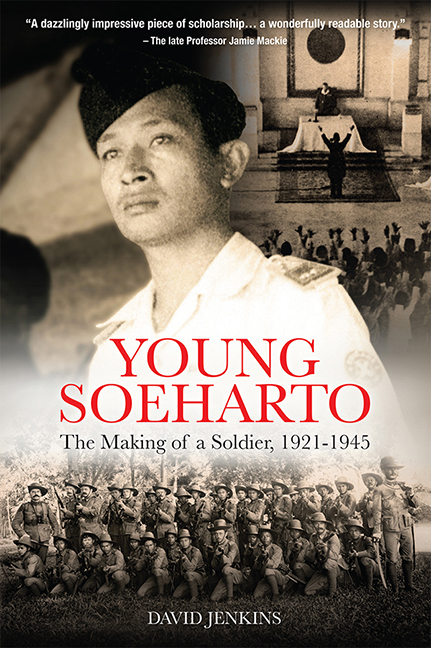Book contents
- Frontmatter
- Contents
- Foreword
- A Note on Spelling and Names
- A Note on Military Organization
- Maps
- List of Charts
- Preface
- Soeharto Family Tree
- 1 “The Sultan came to me and asked about that Family tree”
- 2 “The Cork on which the Netherlands Floats”
- 3 “They Regard Holland as a very Weak Power”
- 4 “An Invisible Motivating Force”
- 5 “What kind of Islam is this?”
- 6 “Soeharto is a Closed Book”
- 7 “I was Suited to the Disciplined life of the Military”
- 8 A Reassuringly Familiar World
- 9 A Policeman for the Japanese
- 10 An Armed Force Conjured out of Nothing
- 11 “The whole Island was Ablaze with Enthusiasm”
- 12 “Don’t make them too Strong!”
- 13 “Soeharto was a Cautious Man”
- 14 “Why did they Choose Soeharto?”
- Glossary and Abbreviations
- Notes
- Acknowledgements
- Bibliography
- Index
- About the Author
9 - A Policeman for the Japanese
Published online by Cambridge University Press: 09 October 2021
- Frontmatter
- Contents
- Foreword
- A Note on Spelling and Names
- A Note on Military Organization
- Maps
- List of Charts
- Preface
- Soeharto Family Tree
- 1 “The Sultan came to me and asked about that Family tree”
- 2 “The Cork on which the Netherlands Floats”
- 3 “They Regard Holland as a very Weak Power”
- 4 “An Invisible Motivating Force”
- 5 “What kind of Islam is this?”
- 6 “Soeharto is a Closed Book”
- 7 “I was Suited to the Disciplined life of the Military”
- 8 A Reassuringly Familiar World
- 9 A Policeman for the Japanese
- 10 An Armed Force Conjured out of Nothing
- 11 “The whole Island was Ablaze with Enthusiasm”
- 12 “Don’t make them too Strong!”
- 13 “Soeharto was a Cautious Man”
- 14 “Why did they Choose Soeharto?”
- Glossary and Abbreviations
- Notes
- Acknowledgements
- Bibliography
- Index
- About the Author
Summary
In the days after the Dutch surrender, Soeharto stayed on in Cisarua, a soldier in a defeated army, waiting to see what would happen next. As a sergeant in the KNIL, he assumed, not unreasonably, that he would become a prisoner of war of the Japanese. For a time nothing happened. Soeharto whiled away the hours playing cards, making, or so he later claimed, a handsome profit in the process. “I had only a guilder in my pocket, but as I played—and won—it soon grew to fifty.” Deciding eventually that he had no wish to be incarcerated in a POW camp with his Dutch and Indonesian military comrades, Soeharto made his way to Cimahi, on the western outskirts of Bandung, accompanied by Amat Sudono, his closest friend in the KNIL. Here, they “bought some ordinary clothes” and discarded their distinctive green KNIL uniforms. Here, too, Soeharto encountered the Japanese army for the first time. “I was taking a break outside a civilian's house,” he recalled. “Japanese soldiers had driven out the Dutchmen who had controlled us for centuries. They looked full of confidence and their countenances were truly frightening.”
A person of pedantic or churlish disposition might be inclined to note that the Dutch had not, in fact, controlled most of the East Indies for centuries. They may have been in the Spice Islands since the 1600s and in Java for a very long time. But in 1942 they had only had full control over Bali, for example, for thirty-four years. That same critic might note that the Dutch had only been able to control Indonesians because they had always been able to find men like Soeharto—men who were willing to take the King or Queen's shilling to keep other Indonesians in their place. A more serious charge might be that Soeharto was now a deserter. Was that the case? The evidence strongly suggests that he was not a deserter. Nor, it would appear, could that be said of aspirant officers (cadetten) such as A.H. Nasution and T.B. Simatupang, who had recently attended the Royal Military Academy in Bandung and who would go on to play a central role in the post-war Indonesian National Army.
- Type
- Chapter
- Information
- Young SoehartoThe Making of a Soldier, 1921–1945, pp. 173 - 205Publisher: ISEAS–Yusof Ishak InstitutePrint publication year: 2021

